
If you are a fan of Squid Game you absolutely must read this article. Don't worry, there will be no spoilers here about the finale of the third season released by Netflix a few days ago, but only a journey through Korean food. This series has shattered every possible record, a fact that no one expected and that demonstrates how the soft power coming from Seoul and its surroundings is becoming increasingly common in Western countries. Coming back to us, those who have seen Squid Game know well that the series does not leave much room for lightheartedness. However, if you look carefully, food plays a role that is anything but secondary. Indeed, it is a key element that helps to understand the emotional state of the characters, the social context in which they move and, more deeply, South Korean culture.
Today we're going to explore all the foods present in the series from the first to the third season and, while we're at it, we'll also open a window on other iconic Korean dishes that, if we had also ended up inside the game, we might have wanted to taste before the last test.
Food as a Symbol of Survival or Inequality?
Let's take a small step back and give the opportunity to those who haven't seen the series (and maybe want to start) to understand the context in which Squid Game is classified, which, even before food, is a fundamental element. The original title is Ojing-eo geim which in Korean means "squid game". It is essentially a children's game, played in South Korea, where you draw a squid on the ground formed by a square, a triangle and a circle. There are two teams and the goal of the "attackers" is to cross the field, get past the defense and reach the squid's head (the final point). The defenders must prevent the attackers from reaching the head.
It is precisely in this dynamic that Squid Game is catalogued, where several participants, submerged in debt and significant economic crises, are recruited for a series of games (popular among Korean children) that take place on an unknown island. At stake is a real mountain of money (almost 45 million dollars) but shortly after the first challenge the dark element emerges. Although they are games for children like hide and seek or "one, two, three, star!" in reality those who fail to overcome them are literally killed by the guards in pink overalls, that is, soldiers with the task of ensuring that everything takes place correctly.
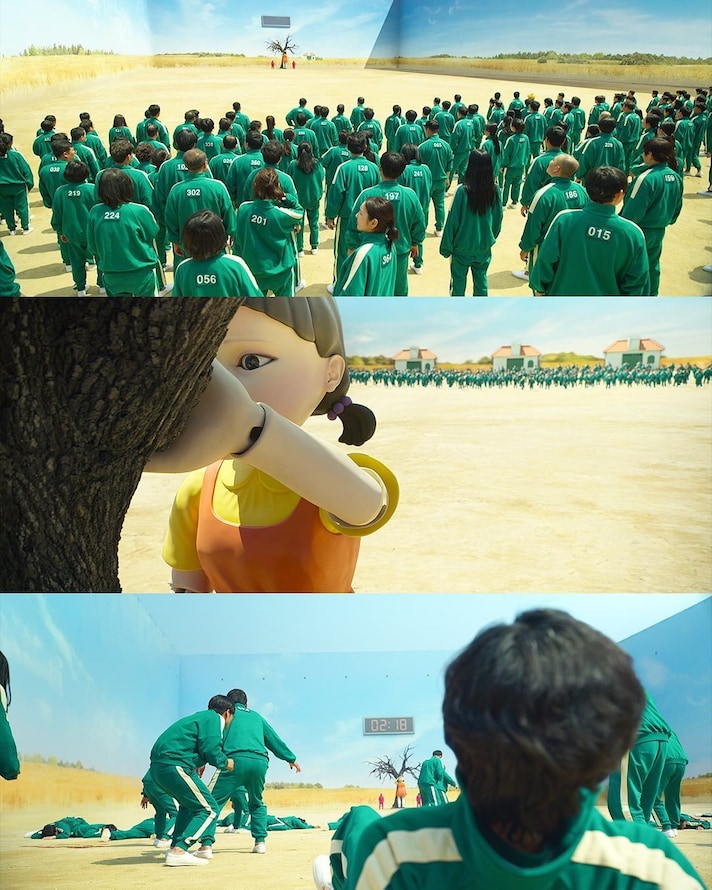
As the series progresses, there will be some pretty disturbing and violent settings whose tone is also set through food, which in some games (like the dalgona cookie) becomes a main element. One of the reasons Squid Game has struck a chord with so many people is its crudeness in showing social inequalities. Food is a perfect mirror of these inequalities, and here is a list of all the famous South Korean dishes that have become famous in the West thanks to Squid Game.
1. Tteokbokki (떡볶이)
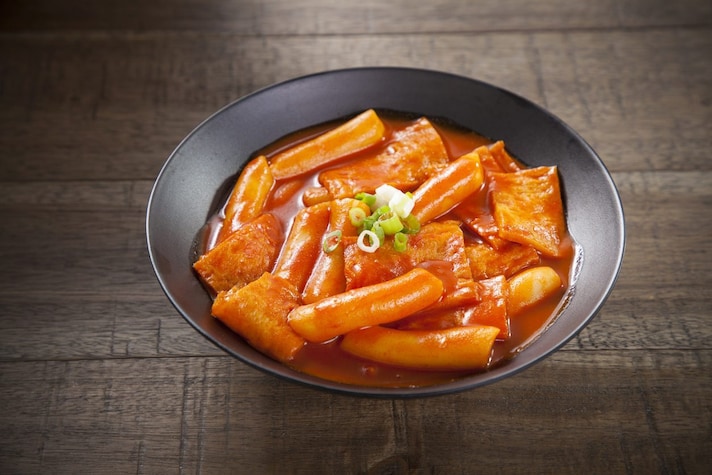
In the very first episode we see the protagonist Seong Gi-hun (played by Lee Jung-jae) who goes to a diner to buy a portion of tteokbokki. We are talking about a very famous dish in South Korea: these are cylindrical rice dumplings accompanied by a very spicy sauce (gochujang). In Seoul they can be found both at street food stalls and in restaurants and are loved by everyone. In the series they take on another meaning: we see Gi-hun buying this dish for his daughter to whom he is very fond. The man has divorced his wife and is overwhelmed not only by debts but also by loan sharks who are after him. The protagonist wants to appear as a caring father and, even if he has no money, he tries to guarantee his daughter a decent meal. The tteokbokki therefore become a fallback dinner but also a gesture of love from a father who cannot see his daughter every day.
2. Gimbap or Kimbap (김밥)
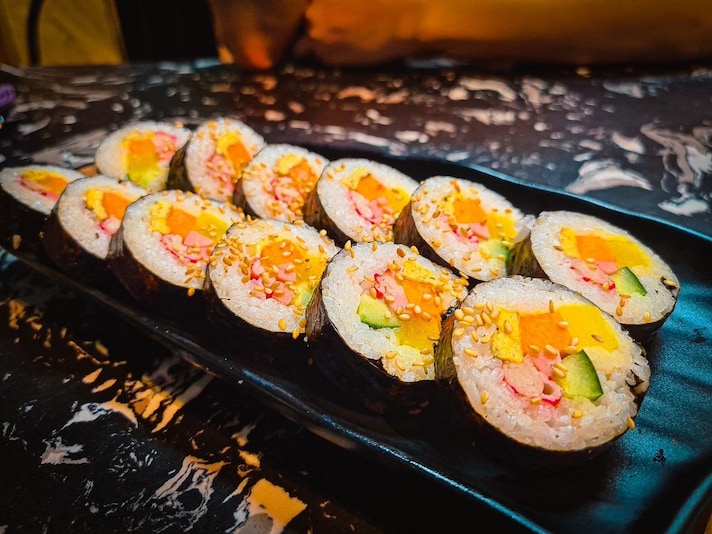
During the second season, the participants of the games are given a portion of gimbap by the pink guards as a meal during a break. Here too, food takes on a symbolic value within the series. It is one of the few moments of "normality" between the deadly and dystopian games. Gimbap is one of the most popular dishes in South Korea: they are rice rolls filled with various ingredients such as fish, meat, eggs, vegetables, kimchi and wrapped in nori seaweed. The rice is seasoned with sesame oil and, unlike Japanese maki, the ingredients inside are all cooked. A characteristic element of this Asian specialty is the pickled yellow daikon (danmuji – 단무지). Traditionally considered a picnic or travel food, gimbap in the series takes on a darker meaning, as it is served in a context of tension and imminent danger.
3. Goguma (고구마)
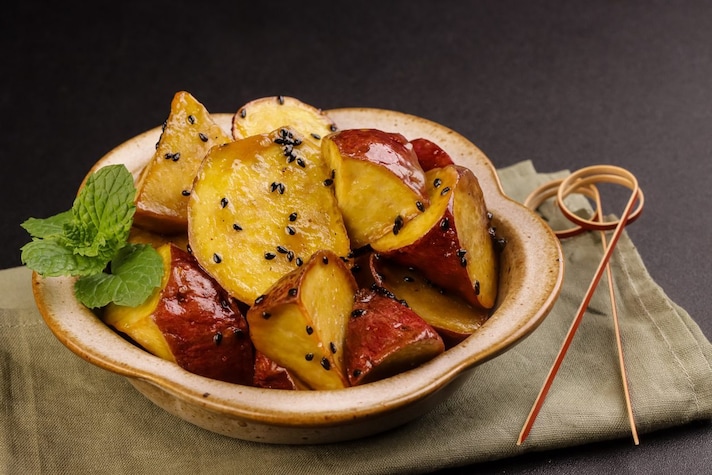
Although the name makes you think of something particular, goguma is actually a dish made from sweet potatoes, which are very popular in Far Eastern countries. A dish that appears in the third season always during the contestants' meal. A simple, tasty and nutritious food that is associated with difficult times in Korean culture in which feelings of nostalgia and resilience are evoked. In the context of the series, sweet potatoes underline the frugality and harshness of the conditions imposed on the players.
4. Bibimbap (비빔밥)
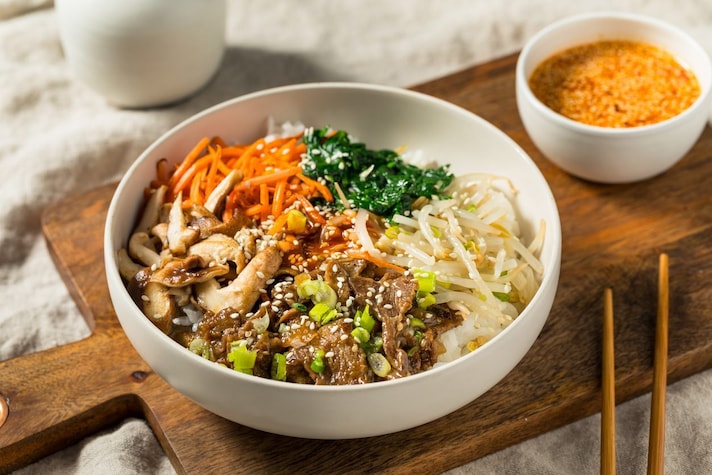
Although not directly shown in the series, bibimbap was included in Netflix's official Squid Game cookbook. A very popular dish that originated in the city of Jeonju and consists of rice, vegetables, meat, and eggs. Complete and nutritious, it represents harmony and balance and contrasts the chaos and desperation that the characters experience during the games.
5. Jjajangmyeon (짜장면)
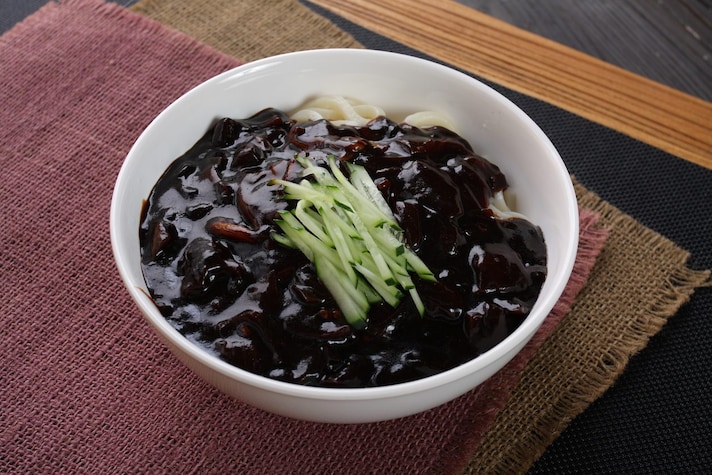
The name of this dish is almost unpronounceable for us Americans but it is very popular in our homeland. These are Korean noodles that appear in the first season with Gi-hun while he eats them disconsolately in a small restaurant. In reality they are also shown a second time and the one eating them is the policeman Jun-ho (played by Wi Ha-joon) in the police station looking for the secret island where the evil children's games are played. In Korea it is a comfort food but it is also a symbol of loneliness and failure. It is jokingly associated with Black Day (April 14) when singles who have not received gifts for Valentine's Day eat jjajangmyeon to console themselves. These are wheat noodles served with a thick sauce of black beans (chunjang), pork or beef, and vegetables. It is a dish born from Sino-Korean cuisine, very popular in take-away and loved by every generation.
6. Dalgona (달고나)
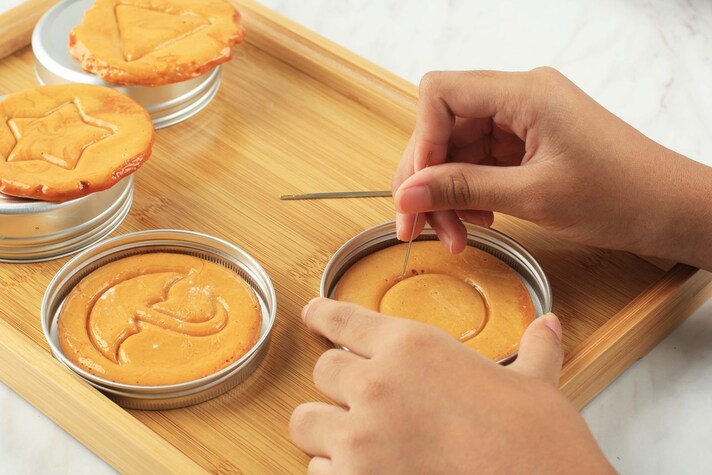
They became the protagonists of a game in the first season called "caramel". It is a cookie – candy made of sugar and baking soda, very popular among Korean children in the 70s and 80s and returned famous in Korea thanks to the series. In Squid Game they are used for a deadly test. But behind it there is a nostalgic aftertaste that many Koreans have recognized and that, paradoxically, we have only discovered thanks to TikTok.
7. The Final Banquets (With Spoilers)
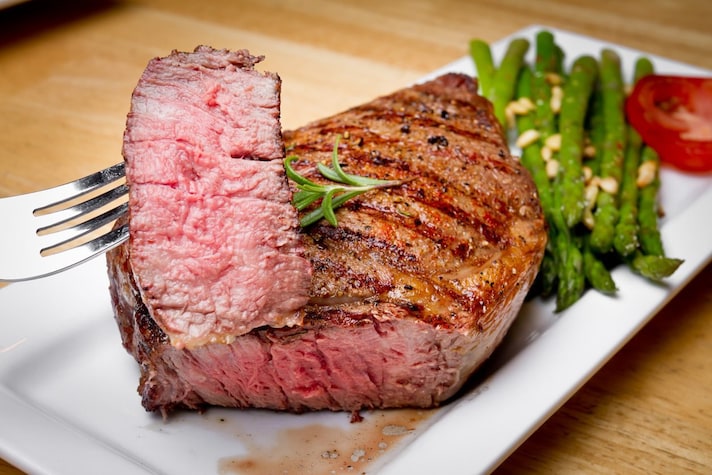
We conclude perhaps with the key moment of the first season, in which food becomes substantially a predominant element. Once the three finalists have reached the end, they are dressed in an elegant suit and led into a festively decorated dining room. Before the final test, the contestants are granted a special "last supper" with a steak cooked to perfection with a silver cutlery set. The scene, however, is only theatrical and shows a cruel irony in which luxury is offered only one step away from death. It is a way to make the contestants feel what it means to be comfortable and to be considered in an elite class, just for a moment, before the final cruelty.
Food is back in the spotlight in the third season with a "last supper," perhaps the most disturbing scene of all. The three finalists – including the protagonist Seong Gi-hun – are welcomed into an elegantly decorated room, with white tablecloths, candelabras, and classical music in the background. The menu? A sumptuous meal consisting of rare steak, glazed asparagus, duchess potatoes, warm bread, and red wine served in crystal glasses. A dinner fit for a high-end restaurant, but served to people who are exhausted, injured, and about to kill themselves. Making the scene even more poignant is the presence of a newborn baby, the daughter of a contestant who is given milk, who sits silently next to the adults: a surreal and disturbing sight. Making the scene even more poignant is the presence of a newborn baby , the daughter of a contestant who is given milk, who sits silently next to the adults: a surreal and deeply disturbing sight. There is nothing convivial about food here. It is a psychological weapon, a staging designed to create a brutal contrast between the elegance of the setting and the violence that is about to explode.
;Resize,width=767;)
